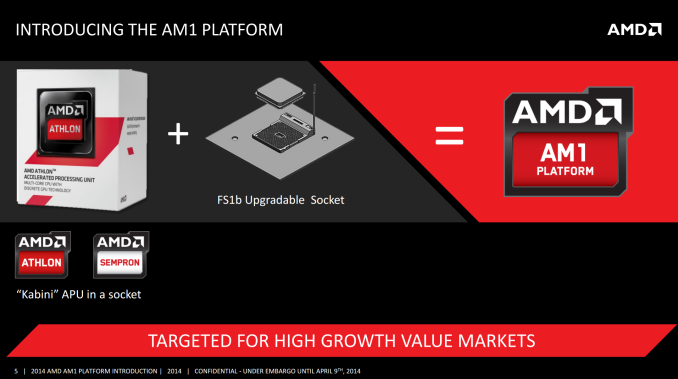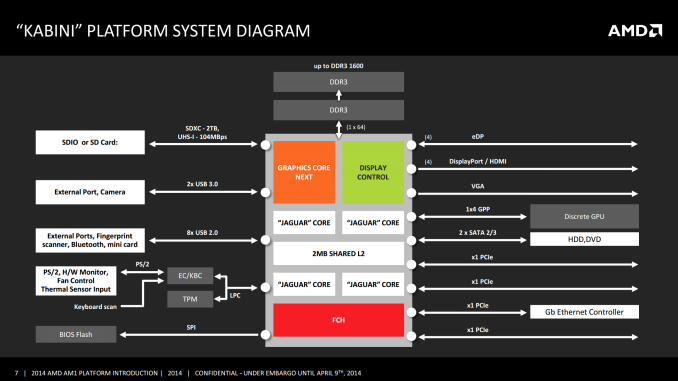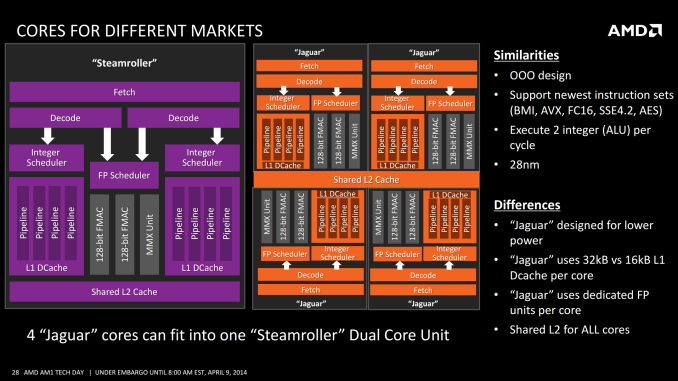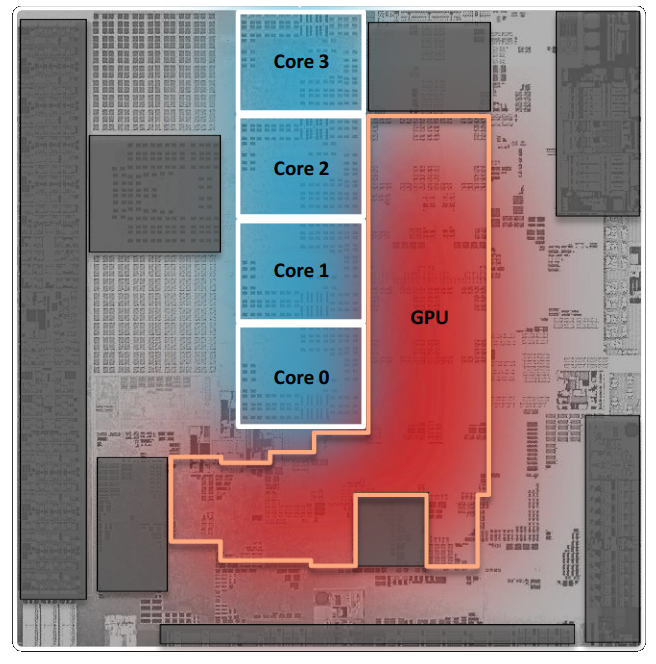AMD AM1 Kabini Part 2: Athlon 5350/5150 and Sempron 3850/2650 Tested
by Ian Cutress on May 29, 2014 2:00 PM EST
While there is a lot of focus on the mainstream desktop market, we hastily reviewed the new entrant to the low-end socketed desktop from AMD, the AM1 Kabini platform back in April. Since then we have acquired all four members of the family, the two quad core Athlon APUs and the two Sempron APUs, for testing. AMD’s movement into the upgradable tablet/desktop crossover arena is an interesting one for sure.
What Is The Point of AM1?
AMD’s reason for releasing a socketed low-power platform was derived from requests in low cost areas of the market. System integrators and companies in South America, Africa and Central Asia wanted a base system which would run an operating system which could be upgraded in the future to higher specification components, rather than sticking with a low-power but non-upgradable mobile CPU. The end result was AM1, the name given to a system using an FS1b socket with a desktop Kabini APU and an aim to build an upgradable CPU/motherboard combination for around $60.
Typically when dealing with the low cost/low power end of the spectrum, these systems are designed such that the APU is soldered on to the motherboard. When a user wants one model in particular, it comes as part of a package, much in the same way as a mobile device. In fact we even played a small game of ‘spot the desktop Kabini’ back at Computex 2013 and saw models such as the aptly named KBN-I from ECS, using the soldered A6-5200 APU:
These systems often find their way into applications that have long upgrade cycles, such as embedded and digital signage. The novelty of an upgradeable, socketed package makes most sense in the desktop arena. With low cost segments focusing more on the entry-level segmentation, AMD believe that having this upgradeability might drive pressure in the entry market towards these upgradeable PC-like devices.
AMD is marketing the series as a cheap, low powered way to go to quad core. When building a CPU architecture there is often a point in frequency scaling which is most efficient, and any deviation from that causes a less-than-linear gain in performance for power. Under this paradigm, and the importance of single core speed, the general feeling at AnandTech is that single core performance is preferred to more cores. If we can get the same multi-core performance using half the number of cores within the same power bracket, then this solution would be preferred. The final piece of that puzzle however comes in terms of design and price, both of which are points that AMD is also aiming to be competitive.
Desktop Kabini
There are a total of four AM1 APUs on the market:
| AMD AM1 Kabini APUs | ||||
| Athlon 5350 | Athlon 5150 | Sempron 3850 | Sempron 2650 | |
| CPU Cores | 4 | 4 | 4 | 2 |
| CPU Frequency | 2.05 GHz | 1.60 GHz | 1.30 GHz | 1.45 GHz |
| GPU Cores | 128 | 128 | 128 | 128 |
| GPU Frequency | 600 MHz | 600 MHz | 450 MHz | 400 MHz |
| Memory Frequency | 1600 MHz | 1600 MHz | 1600 MHz | 1333 MHz |
| L2 Cache | 2 MB | 2 MB | 2 MB | 1 MB |
| TDP | 25 W | 25 W | 25 W | 25 W |
| Official Launch Price | $59 | $49 | $39 | $31 |
Each of these APUs features up to four 28nm Jaguar cores and a 128 SP implementation of AMD's GCN GPU. We've gone over both the Jaguar and GCN architectures in previous articles, so we won't spend a lot of time recapping them here. Jaguar is the latest in AMD's line of "cat" cores, designed to go up against Intel's Atom. GCN on the other hand is a well-known GPU design from AMD as well, cut down here to fit in a much smaller die area (and thermal envelope).
The Jaguar cores in Kabini are listed as 3.1mm2, and AMD is quoting that four of these cores will fit into a single Steamroller module. Unfortunately the dimensions of a Steamroller module are not known - a 32nm SOI Bulldozer module clocked in at 30.9 mm2 for example, but no equivalent number is available for 28nm Steamroller. However some quick math shows four Jaguar cores populates 12.4 mm2. This leaves the rest of the core for the L2 cache, IGP and a large amount of IO.
In fact there are a few images that can help us predict total die size. In AMD’s slide deck, we have the following:
Given that one core is 3.1 mm2, extrapolating out gives the size of the die at 31.4x the size of a single core, or 97.3 mm2. The GPU area is approximately 5.2x the size of a core, giving ~16.1 mm2 for 128 GCN cores, compared to 12.4 mm2 for CPU cores. The Video Codec Engine and Unified Video Decoder are not part of these totals, located on other parts of the APU. The memory controller clocks in at ~9.4 mm2 and the display/IO portion runs at ~7.3 mm2.


















87 Comments
View All Comments
Silver47 - Thursday, May 29, 2014 - link
They are in the graphs, what are you smoking?Novaguy - Thursday, May 29, 2014 - link
I think using a weaker card for the dgpu would also have been interesting. Maybe something like an r7 270, 7750 or 7770.Also, what about Mantle benchmarks?
Novaguy - Thursday, May 29, 2014 - link
I meant r7 250, not 270... can't seem to edit via mobile.V900 - Friday, May 30, 2014 - link
No, no Mantle benchmarks... It's useless, and only serves to clutter the article.Hardly anybody cared about Mantle when it was announced... And now that we know the next version of Direct X is coming, the only people that care the slightest, are a handful of AMD fanbois.
silverblue - Friday, May 30, 2014 - link
You're entitled to your opinion. Let's look at it this way - DirectX 12 won't be here for another 18 months. Also, Mantle has been shown to perform better than AMD's own implementation of DX11 (and sometimes faster than NV's as well) and also helps with lower performing CPUs.The following link only shows the one game, but it should be enough to highlight the potential benefit of Mantle on a comparatively weak architecture such as Jaguar:
http://www.pcper.com/reviews/Graphics-Cards/AMD-Ma...
If you didn't need to upgrade your CPU to play the latest and greatest, I think you'd care, too.
formulav8 - Friday, May 30, 2014 - link
If Mantle was from NVidia or Intel you would be a bigger stooge than anyone AMD.Gauner - Thursday, May 29, 2014 - link
I think it would be far more useful for this weak systems to have a different set of game tests.No one will buy one of those to play tomb raider or bioshock but I'm guessing some people would consider buying one if you could play for example league of legends or dota2 at minimum and 720/1080p.
I understand it would mean an extra effort but right now the gaming tests don't really tell anything useful nor do they add useful information to other reviews by having an extra comparison.
Just taking into account steam games(since they are the easier ones to get data about) in the top 5 most played games daily you always have: dota2, CS:GO and TF2. Those 3 games used to run(poorly, 800x600, low detail, 20-30fps) in the old Intel GMA4500M so in my opinion they have a lot of people potentially interested in them and would run well enough in low power systems to give a useful comparison between chips.
res057 - Thursday, May 29, 2014 - link
Tests with high end games and cpu intensive tasks for processors such as these is like Car and Driver putting a Prius through quarter-mile test and comparing the results with a Corvette. Pointless.Gauner - Friday, May 30, 2014 - link
I can understand the logic behind CPU intensive tasks, even if you wont use this kind of CPUs to compress video with x264 you can watch the results and get a realistic estimation on the performance difference because the test is the same for both weak CPUs and high end CPUs.Problem with the gaming tests is that the comparison is with settings completely different from the high end tests so no parallelism there and with a set of games that no one would think to play in weak systems so there is no useful info given.
I cant look at the results and say "since tomb raider at 1280x1024 with low graphics ran at 20fps I guess league of legends will run at 1080p with medium graphics and 35fps", there are too many different points to make a comparison(AAA engine vs engine designed for low power computers, different resolution, completely different poly count and texture sizes, ...).
takeship - Friday, May 30, 2014 - link
I'm curious why no comparison with the old E-450/E-2000 Jaguar chips. Not so much for the CPU performance, but for the GPU improvements going to GCN.